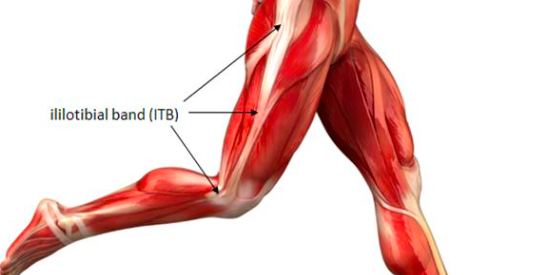What is ITB Syndrome
The Iliotibial (IT) band is a thick formation of fascia that runs along the outside of the thigh from the hip to the knee. It extends over the outside of the pelvis, over the hip and inserts just below the knee. Its major role is to stabilize the knee and abduct the hip by moving behind the femur to the front during activities such as walking or running. It also resists varies torques (excessive rotational forces) at the knee.
Being a fascia band that is dense and fibrous connective tissue, it can withstand increased loads from multidirectional. ITBS is an inflammatory response caused by excessive, repetitive loads on the band that causes strain in the outer portions of the band. This causes pain and soreness on the outside of the knee (lateral) and is aggravated during activities such as running and cycling. Where the band attaches in the knee, there is bursae, and with the increased tension causes these bursae to be inflamed and sore, which results in decreased range of motion, which often results in inefficient running gait and technique.
Iliotibial band syndrome is a non-traumatic overuse injury that often affects long-distance runners or cyclists. In runners approximately 12% of overuse injuries is related to the iliotibial band. The majority of iliotibial band syndrome cases can be resolved with a conservative treatment approach that has an emphasis on rehabilitative exercises. Cases of surgical intervention are rare and should only be suggested if all other treatment modalities have been explored. A successful treatment of ITB syndrome requires patience and compliance of specific prescribed exercise programs.
Symptoms of ITBS
The main symptoms of ITB syndrome are tightness in the lateral thigh especially along the outer portion where the band is located. This eventually progresses to a gradual onset of burning or pain at the lateral aspect of the knee where the band inserts. The pain can radiate to the outside thigh and lower calf. It can also be on the outside of the hip and start causing some sort of bursitis at the hip. There can also be some swelling on the lateral knee depending on the severity and chronicity of the problem. Rest can resolve the symptoms initially but as soon as activity is resumed the pain comes back.
Common Causes of ITBS
One of the most common causes of ITB syndrome is a sudden increase in training intensity or quantity. Generally, if training is not progressed adequately (more than 5-10% per week), the muscles, tendons, ligaments and bones of the knee, hip and pelvis cannot adapt appropriately to the sudden increased stress and pain will begin. Other causes are weakness in the Gluteus Maximus, and Gluteus Medius which are stabilizers of the hip especially when we stand on 1 leg which is equivalent to how we run. Weakness in these muscles increases the knee valgus and stress on the outside of the knee. Other causes are:
- Inappropriate footwear or a change in footwear can contribute to ITBS.
- Excessive pronation of the foot. This increases the torsional forces at the knee and creates more strain on the insertional points of the ITB.
- Dehydration Our fascia system of our body comprises mainly of water. So, if you are not hydrated, your fascia is going to become tight.
- Lack of movement Our body was meant to move. If you are not moving the fascia forms sticky adhesions between the fascial surfaces and over time will inhibit range of motion.
- Inadequate warm-up and cool down As a child you could just run out the door and keep on running. Warming up wasn’t even thought of and cooling down meant having a drink of water or putting ice down the back of your shirt. After years of these inadequacies the body will start to build up the increased stressors and eventually fail you.
Treatment of ITBS
When looking at treating ITB syndrome, conservative approaches are always the first line of care. In most severe cases, medical interventions of cortisone injections might be an option or even surgery where they cut the ITB as it inserts into the knee. These approaches should only be considered after all conservative treatments have failed. Firstly, we assess what the primary cause of the ITBS is. This is where a qualified professional such as a chiropractor, physiotherapist or podiatrist should be sought for an opinion. Once the primary cause has been identified then tailoring a rehabilitation and treatment schedule can be implemented. Main parts of a treatment plan should include:
- Exercises that target mobility and strength
- Correction of biomechanical inadequacies from the hip, knee, pelvis, and foot from a specialist such as the practitioners here at Neurohealth
- Stretching the ITB. When stretching fascia, stretches need to be held for 3-4 minutes
- Foam rolling of the ITB fascia
- Increasing the mobility of the hip in external and internal rotation
- Balancing the pelvis
- Strengthening the Gluteus Medius
- Improving the balance of the leg with eyes open and closed whilst standing on one leg
- Having a massage of the affected muscles and myofascial systems of the body
If you have any questions regarding ITB Syndrome or would like to make an appointment to speak to one of the health practitioners at Neurohealth please contact us on 02 9905 9099 or admin@neurohealthchiro.com.au




